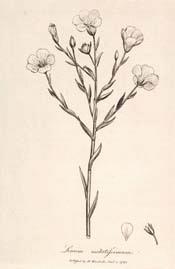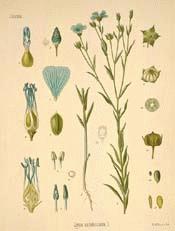
Botanical.com Home Page
FlaxBotanical: Linum usitatissimum (LINN.)
|

|
(Linum usitatissimum LINN.) Click on graphic for larger image |
Its cultivation reaches back to the remotest periods of history, Flax seeds as well as the woven cloth having been found in Egyptian tombs. It has been cultivated in all temperate and tropical regions for so many centuries that its geographical origin cannot be identified, for it readily escapes from cultivation and is found in a semi-wild condition in all the countries where it is grown.
The 'fine linen' mentioned in the Bible has been satisfactorily proved to have been spun from Flax; it was the plant to which the plague of hail proved so disastrous (Exodus ix. 31). Joseph was arrayed in this product (Genesis xii. 42), and it also furnished the garments of the Jewish High-Priests (Exodus xxviii.) as well as the curtains of the Tabernacle (Exodus xxvi. 1). We learn that the knowledge of spinning this linen was known to the Canaanites (see Joshua ii. 6), and in New Testament times it formed the clothing of the Saviour in the tomb where Joseph of Arimathaea laid Him.
It was used for cord and sail-cloth ('white sails' are mentioned by Homer in the Odyssey), and it was used for lamp-wicks (Isaiah xlii. 3).
The seed-vessels with their five-celled capsules are referred to in the Bible as 'bolls,' and the expression 'the flax was bolled' (Exodus ix. 31) means that it had arrived at a state of maturity. When the bolls are ripe, the Flax is pulled and tied in bundles, and in order to assist the separation of the fibre from the stalks, the bundles are placed in water for several weeks, and then spread out to dry. This custom is alluded to in Joshua ii. 6.
- Pliny writes:
- 'What department is there to be found of active life in which flax is not employed? And in what production of the Earth are there greater marvels to us than in this? To think that here is a plant which brings Egypt to close proximity to Italy! - so much so, in fact, that Galerius and Balbillus, both of them prefects of Egypt, made the passage to Alexandria from the Straits of Sicily, the one in six days, the other in five! . . . What audacity in man! What criminal perverseness! Thus to sow a thing in the ground for the purpose of catching the winds and tempests; it being not enough for him, forsooth, to be borne upon the waves alone!'
Of the making of tow 'uneven and full of knobs' used for stuffing into the cracks in ships, and 'for bonds and byndynges and matches for candelles, for it is full drye and taketh sone fyre and brenneth.' 'And so,' he concludes somewhat breathlessly, 'none herbe is so needfull to so many dyurrse uses to mankynde as is the flexe.'
- Darwin studied several species of Linum, and found that some like the primrose had flowers with two forms of stamens and pistil. His object was to test the relative degrees of fertility of the long and short-styled pistils. L. perenne, for instance, is dimorphic:
- 'Of the flowers on the long-styled plants he found that twelve were fertilized with their own form pollen, but from a different plant. A seed capsule was only set when pollinated from anthers of the same height as the stigmas.'
- So Darwin concluded:
- 'We have the clearest evidence that the stigmas of each form require for full fertility that pollen from the stamens of a corresponding height, belonging to the opposite form, should be brought to them.' (Forms of Flowers, p. 92.)
The Flax is a graceful little plant with turquoise blue blossoms, a tall, erect annual, 1 to 2 feet high, the stems usually solitary quite smooth, with alternate, linear, sessile leaves, 3/4 to 1 inch long.
Many traditions are associated with this useful plant. Flax flowers were believed in the Middle Ages to be a protection against sorcery. The Bohemians have a belief that if seven-year-old children dance among Flax, they will become beautiful, and the whole plant was supposed to be under the protection of the goddess Hulda, who, in Teuton mythology, was held to have first taught mortals the art of growing Flax, of spinning, and of weaving it.
[Top]
---Cultivation and Preparation for Market---Linseed requires ground as rich as for wheat, and if cultivated for seed is not of much use for Flax.
Its cultivation in this country could only pay on a large scale. The very exhausting nature of the crop has prevented its extensive cultivation in England, and the area under cultivation has declined in consequence. This peculiarity was well known to the Ancients, and Pliny asserted that it scorched the ground. Its culture requires care and suitable soil to secure a good crop. It has been grown in large quantities in the alluvial soils of Lincolnshire and in the eastern counties, and flourishes well in Ireland. It succeeds best in deep, moist loams such as contain a large proportion of vegetable matter, in good condition, firm, not loose. Strong clays do not answer well, nor poor soils, nor such as are of a gravelly or sandy nature, nor should the soil be freshly manured.
It is best treated as a farm crop. Being quickly grown and quickly harvested, it can be grown after a winter root crop, being over and reaped in time to secure a catch crop for the following season. The seed, which must be kept dry, as damp injures it, is sown in March or April, in drills, 70 lb. to the acre, on land carefully prepared and freed from weeds by ploughing. The crop itself must be handweeded, or the roots, being surface rooted, will be injured. It should be reaped in August, before the seed is fully ripe. The fibres of the plant, when grown for Flax, are found to be softer and stronger when the blossom has just fallen and the stalk begins to turn yellow before the leaves fall, than if left standing till the seeds are quite mature. The seeds, however, will ripen after the plant is gathered, if they be allowed to remain on the plant for a time. The Dutch avail themselves of this fact with regard to their Flax crops. After pulling the plants they stack them. The seeds by this means ripen, while the fibres are collected at the most favourable period of their growth. They thus obtain both of the valuable products of the plant.
[Top]
---Parts Used Medicinally---The fruit is a globular capsule, about the size of a small pea, containing in separate cells ten seeds, which are brown (white within), oval-oblong and flattened, pointed at one end, shining and polished on the surface, 1/6 to 1/4 inch long. They are inodorous except when powdered, but the taste is mucilaginous and slightly unpleasant.
Linseed varies much in size and tint - a yellowish variety occurring in India. Holland, Russia, the United States, Canada, the Argentine and India furnish the principal supplies. The Russian seed or Dutch-grown of Russian origin, though small, is preferred for Flax-growing, as it is hardier than the large southern seed from the Mediterranean and India. For medicinal purposes, English and Dutch seeds are preferred, on account of their freedom from weed-seeds and dirt. If containing more than 4 per cent of weedseeds, linseed may be said to be adulterated. Of English and Dutch seeds about twelve weigh 1 grain, but some of the Indian and Mediterranean varieties are twice as large and heavy.
[Top]
---Constituents---The envelope or testa of the seed contains about 15 per cent of mucilage. The seeds themselves contain in the cotyledons and endosperm from 30 to 40 per cent of a fixed oil, of a light yellow colour, and about 25 per cent proteids, together with wax, resin, sugar, phosphates, acetic acid, and a small quantity of the glucoside Linamarin. On incineration, linseed should not yield more than 5 per cent of ash.
The oil is obtained by expression, with little or no heat. The cake which remains after expressing the oil, and which contains the farinaceous and mucilaginous part of the seed, is familiarly known as oil-cake, and is largely used as a fattening food for cattle. It is also used as a manure. When ground up, it is known as linseed meal, which is employed for making poultices. The meal is sold in two forms, crushed linseed and linseed meal. Formerly linseed meal was always obtained by grinding English oil-cake to powder and contained little oil, but now the crushed seeds, containing all the oil, are official. Crushed linseed of good quality usually contains from 30 to 35 per cent of oil.
Linseed oil rapidly absorbs oxygen from the air and forms, when laid on in thin layers, a hard, transparent varnish. It is largely used in the arts for its properties as a drying oil. It is a viscid, yellow liquid, its chief constituent being Linolein. It also contains palmitin, stearin and myristin, with glyceride of linoleic acid. Boiled oil, produced by heating raw linseed oil to a temperature of 150 degrees C., together with a small proportion of a metallic drier, possesses the drying properties of linseed oil to an enhanced degree. It becomes of a brown colour and dries much more rapidly, and in this state is used in the manufacture of printer's ink.
[Top]
---Medicinal Action and Uses---Emollient, demulcent, pectoral. The crushed seeds or linseed meal make a very useful poultice, either alone or with mustard. In ulceration and superficial or deep-seated inflammation a linseed poultice allays irritation and pain and promotes suppuration. The addition of a little lobelia seed makes it of greater value in cases of boils. It is commonly used for abscesses and other local affections.
Linseed is largely employed as an addition to cough medicines. As a domestic remedy for colds, coughs and irritation of the urinary organs, linseed tea is most valuable. A little honey and lemon juice makes it very agreeable and more efficacious. This demulcent infusion contains a large quantity of mucilage, and is made from 1 OZ. of the ground or entire seeds to 1 pint of boiling water. It is taken in wineglassful doses, which may be repeated ad libitum.
Linseed oil, mixed with an equal quantity of lime water, known then as Carron Oil, is an excellent application for burns and scalds.
Internally, the oil is sometimes given as a laxative; in cases of gravel and stone it is excellent, and has been administered in pleurisy with great success. It may also be used as an injection in constipation. Mixed with honey, linseed oil has been used as a cosmetic for removing spots from the face.
The oil enters into veterinary pharmacy as a purgative for sheep and horses, and a jelly formed by boiling the seeds is often given to calves.
Linseed is often employed, with other seeds, as food for small birds.
Plantain seeds, also a favourite food of small birds, can, it is said, be used instead of linseed in making poultices, as they contain much mucilage, though not so much oil.
Linseed has occasionally been employed as human food - we hear of the seeds being mixed with corn by the ancient Greeks and Romans for making bread - but it affords little actual nourishment and is apparently unwholesome, being difficult of digestion and provoking flatulence.
The meal has sometimes been used fraudulently for adulterating pepper.
[Top]
|
Purchase from Richters Seeds
Flax (Linum usitatissimum) Seeds Evelin Fibre Flax (Linum usitatissimum 'Evelin') Seeds Blue Flax (Linum perenne) Seeds |
© Copyright Protected 1995-2025 Botanical.com
